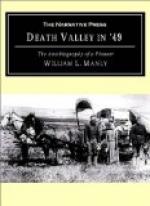When I told Chief Walker this he seemed very much astonished, as if wondering why we were going down the river when we wanted to get west across the country. I asked him how many sleeps it was to the big water, and he shook his head, pointed out across the country and then to the river and shook his head again; by which I understood that water was scarce, out the way he pointed. He then led me down to a smooth sand bar on the river and then, with a crooked stick, began to make a map in the sand. First he made a long crooked mark, ten feet long or so, and pointing to the river to let me know that the mark in the sand was made to represent it. He then made a straight mark across near the north end of the stream, and showed the other streams which came into the Green river which I saw at once was exactly correct. Then he laid some small stones on each side of the cross mark, and making a small hoop of a willow twig, he rolled it in the mark he had made across the river, then flourished his stick as if he were driving oxen. Thus he represented the emigrant road. He traced the branches off to the north where the soldiers had gone, and the road to California, which the emigrants took, all of which we could see was correct. Then he began to describe the river down which we had come. A short distance below the road he put some small stones on each side of the river to represent mountains. He then put down his hands, one on each side of the crooked mark and then raised them up again saying e-e-e-e-e-e as he raised them, to say that the mountains there were very high. Then he traced down the stream to a place below where we made our canoes; when he placed the stone back from the river farther, to show that there was a valley there; then he drew them in close again farther down, and piled them up again two or three tiers high, then placing both fists on them he raised them higher than the top of his head, saying e-e-e-e-e-e and looking still higher and shaking his head as if to say:—“Awful bad canon”, and thus he went on describing the river till we understood that we were near the place where we now were, and then pointed to his tepee, showing that I understood him all right. It was all correct, as I very well knew and assured me that he knew all about the country.




